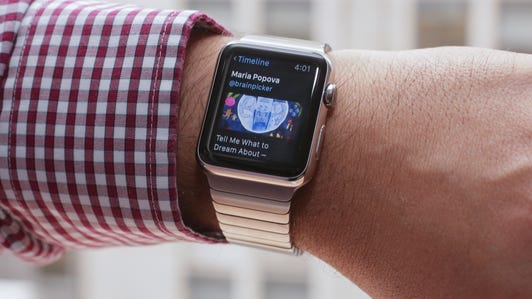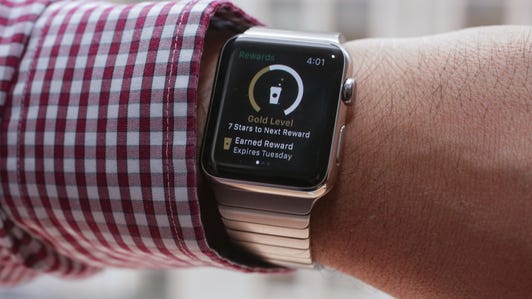
James Martin/CNET
iPhone sales drove Apple to yet another strong quarter.
The company blew away Wall Street expectations for its fiscal second quarter, which ended March 28, as iPhone and Mac sales set a record for the period. Apple also reported all-time record performance for its App Store and forecast strong sales for the current period.
“We’re seeing fantastic results for iPhone, with revenue growth of 55 percent year on year, and we’re seeing a higher rate of [people switching to the iPhone] than we’ve experienced in previous iPhone cycles,” Apple CEO Tim Cook said during a call with analysts.
He added that strength in emerging markets — especially Greater China, which passed Europe to become Apple’s second-biggest sales market — buoyed the company’s financial results, with revenue up 58 percent.
The Apple Watch may be what everyone’s talking about, but it’s still the iPhone driving Apple’s financial results. For the second period in a row, the iPhone accounted for more than two-thirds of Apple’s total revenue, higher than the typical level closer to 50 percent. Consumers have been scooping up Apple’s larger-screen smartphones — the 4.7-inch iPhone 6 and 5.5-inch iPhone 6 Plus — at record rates since they hit the market in September. But they’ve also stopped buying as many iPads, Apple’s No. 2 moneymaker after its smartphones.
In the second quarter ended March 28, Apple sold 61.2 million iPhones, up from 43.7 million in the year-earlier period but below the record 74.5 million sold in the previous holiday-bolstered quarter. Analysts expected the company to sell 57.2 million iPhones in its second quarter, according to a poll by Fortune.
Sales of the device drove Apple to report revenue up 27 percent to $58 billion, above the $56.08 billion anticipated by analysts polled by Thomson Reuters. Net income rose to $13.6 billion, or $2.33 a share, up from $10.2 billion, or $1.66 a share. Analysts had expected earnings of $2.16 a share.
It was “clearly a good quarter as they beat Street expectations for both revenue and earnings,” Gartner analyst Van Baker said.
Apple shares rose 1.3 percent to $134.38 in after-hours trading. As of market close Monday, the stock has jumped 20 percent since the beginning of January and 62 percent over the past 12 months.
The period doesn’t come close to Apple’s blockbuster December quarter — which saw the highest revenue in Apple’s 38-year history and the biggest profit of any public company ever — but Apple benefited from strong sales in Greater China. Revenue in the region, which got a boost from the Chinese New Year in February, soared to a record $16.8 billion from $9.84 billion a year ago. China was the only region detailed in Apple’s earnings report where second-quarter sales topped those of the first quarter, though up a scant 4 percent.
“It was an incredible quarter,” Cook said. “I’ve never seen as many people coming into the middle class as they are in China, and that’s the bulk of our sales, and we’re really proud and continue to invest in the country.”
See also
- Waiting for the Apple Watch: A less than luxury experience
- Apple Watch store launches with 3,000 apps
- CNET’s take on the Apple Watch
Mum on Apple Watch
The report comes only three days after Apple’s newest gadget, Apple Watch, hit the market. The smartwatch, which requires an iPhone 5 or later to run basic apps and receive notifications, is Apple’s first new device since the iPad launched five years ago and the first new product category under the leadership of Cook. It’s key for Apple to show it’s still an innovator and can expand beyond its wildly successful iPhone franchise, which makes up the bulk of sales and profits.
So far, Apple Watch has been experiencing long shipping delays. Wait times for the device, which costs from $349 for the sport version to $17,000 for the gold edition, now stretch into July. Research firm Slice Intelligence on Sunday estimated only 22 percent of US customers who preordered the Apple Watch received their devices in the first weekend it was available. Apple hasn’t revealed the watch’s sales figures, and it doesn’t plan to break out the results in its quarterly reports. Still, some analysts believe the company has sold 2 million Apple Watch units in just the two weeks of preorders, which started April 10.
Cook on Monday declined to provide any information about Apple Watch sales but said supply should be ample enough for Apple to launch the smartwatch in new countries by late June. Initially, Apple Watch has been available in Australia, Canada, China, France, Germany, Hong Kong, Japan, the UK and the US.
“Right now demand is greater than supply, so we’re working hard to remedy that,” Cook said Monday. He added that there are now 3,500 apps available for the Apple Watch, up from 3,000 as recently as the day the smartwatch hit the market.
iPad vs. Mac
iPad sales posted their fifth consecutive decline to 12.6 million units from 16.4 million a year earlier. Analysts expected Apple to sell 14.1 million iPads, according to an analyst poll by Fortune. Consumers have been holding on to their tablets for longer and opting to purchase bigger-screen iPhones instead.
During the earnings call Monday, Cook acknowledged that consumers are buying iPhones and Macs instead of iPads, but he said it’s not something that worries Apple. He expects iPad sales to stabilize at some point but couldn’t predict when it would happen.
“I believe the iPad is an extremely good business over the long term,” Cook said. “When precisely it begins to grow again, I wouldn’t want to predict, but I strongly believe that it will.”
Apple introduced its newest tablets — the iPad Air 2 and the iPad Mini 3 — in October, but analysts said their incremental changes, including faster processors, weren’t enough to attract buyers. The company, which has long claimed iPad weakness is a “speed bump,” is now counting on a partnership with IBM to increase iPad sales to business users.
At the same time, Mac sales have been strong. Apple sold 4.6 million Macs, up from 4.1 million a year ago.
The company introduced its newest MacBook earlier this month. The device, Apple’s thinnest and lightest computer yet, adds gold and space gray options to the traditional silver finish. Analysts expect the device to start helping Mac sales in the current quarter.
Gross margin grew to 40.8 percent from 39.3 percent in the year-ago quarter. Analysts had projected 39.6 percent. Apple’s gross margin, a measure of sales after removing costs like manufacturing, has fallen since its high of 47.4 percent in early 2012 as customers opt for lower-cost devices.
For the fiscal third quarter, which ends in June, Apple projected revenue of $46 million to $48 million, largely in line with the $47.09 billion forecast by analysts, according to Thomson Reuters. Apple typically forecasts lower sales than analysts estimate.
Along with reporting strong results, Apple boosted its dividend to 52 cents from 47 cents a share and increased the amount of cash it’s returning to shareholders to $200 billion by March 2017. It previously said it would pay $130 billion to shareholders by the end of 2015.
Apple has been taking steps to return more cash to shareholders since Cook took over as CEO. A year ago, Apple announced it would give investors six additional shares of stock for every Apple share they owned as of June 2, 2014. Because of the split, shares now trade at a much lower level than in the past — around $100 instead of $600 — but it also makes the stock more accessible to investors. Still, some investors, such as Carl Icahn, have asked for Apple to distribute even more of its massive cash hoard to shareholders.
Updated at 1:55 p.m. PT with analyst comment, and at 3:30 p.m. PT with comments from CEO Tim Cook from the conference call.
14 third-party Apple Watch apps we like (pictures)









